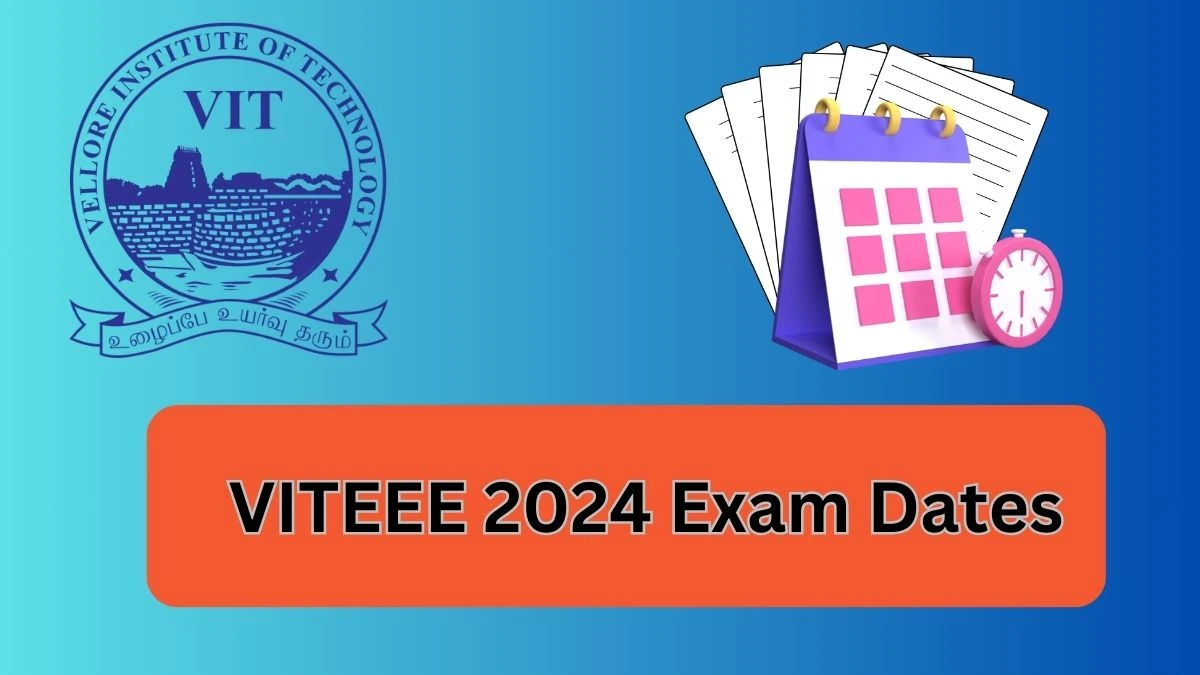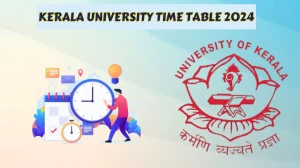VITEEE 2024 Exam Dates (Announced) viteee.vit.ac.in Vellore Institutes of Technology All Details Here
by Keerthika
Updated Mar 13, 2024

VITEEE 2024 Exam Dates @ viteee.vit.ac.in
Vellore Institute of Technology has issued the dates for the VITEEE 2024 exam. The exam is slated to occur in 2024 between April 19 and April 30, 2024. The registration process for VITEEE 2024 is still open. The VITEEE 2024 application deadline is March 30, 2024. Online applications are available for candidates at viteee.vit.ac.in, the official website.
Check - VITEEE 2024 Exam Dates
Download - VITEEE 2024 Exam Dates
VITEEE 2024 - Overview
|
Full Exam Name |
VIT Engineering Entrance Exam |
|
Short Exam Name |
VITEEE |
|
Conducting Body |
Vellore Institute of Technology |
|
Frequency of Conduct |
Once a year |
|
Exam Level |
University Level Exam |
|
Languages |
English |
|
Mode of Application |
Online |
|
Application Fee (General) |
1350 Rs [Online] |
| Mode of Exam | Online |
| Mode of Counselling | Offline |
| Participating Colleges | 4 |
| Exam Duration | 2 Hours 30 Minutes |
VITEEE 2024 Syllabus
Physics: Unit 01
|
Laws of motion and work, energy and power |
|---|
|
Law of conservation of linear momentum and its applications |
|
Static and kinetic friction, laws of friction, rolling friction, lubrication |
|
Work done by a constant force and a variable force; kinetic energy, work-energy theorem, power |
|
Conservative forces: Conservation of mechanical energy (kinetic and potential energies), non-conservative forces: Motion in a vertical circle, elastic and inelastic collisions in one and two dimensions |
Physics: Unit 02
|
Properties of matter |
|---|
|
Elastic behaviour, stress-strain relationship, Hooke's law, Young's modulus, bulk modulus, shear modulus of rigidity, Poisson's ratio, elastic energy |
|
Viscosity, Stokes' law, terminal velocity, streamline and turbulent flow, critical velocity |
|
Bernoulli's theorem and its applications |
|
Heat, temperature, thermal expansion: Thermal expansion of solids, specific heat capacity: Cp, Cv-latent heat capacity |
|
Qualitative ideas of blackbody radiation: Wein's displacement law, Stefan's law |
Physics: Unit 03
|
Electrostatics |
|---|
|
Charges and their conservation; Coulomb’s law-forces between two point electric charges, forces between multiple electric charges-superposition principle |
|
Electric field, electric field due to a point charge, electric field lines; electric dipole, electric field intensity due to a dipole, behaviour of a dipole in a uniform electric field |
|
Electric potential, potential difference-electric potential due to a point charge and dipole, equipotential surfaces, electrical potential energy of a system of two point charges |
|
Electric flux, Gauss’s theorem and its applications |
|
Electrostatic induction, capacitor and capacitance, dielectric and electric polarisation, parallel plate capacitor with and without dielectric medium, applications of capacitor, energy stored in a capacitor, capacitors in series and in parallel |
|
Action of points, Van de Graaff generator |
Physics: Unit 04
|
Current electricity |
|---|
|
Electric current, flow of charges in a metallic conductor, drift velocity and mobility and their relation with electric current |
|
Ohm’s law, electrical resistance, V-I characteristics, electrical resistivity and conductivity, classification of materials in terms of conductivity, carbon resistors, colour code for carbon resistors, combination of resistors, series and parallel |
|
Temperature dependence of resistance, internal resistance of a cell, potential difference and EMF of a cell, combinations of cells in series and in parallel |
|
Kirchoff’s law, Wheatstone’s bridge and its application for temperature coefficient of resistance measurement, metre bridge, special case of Wheatstone bridge, potentiometer principle, comparing the EMF of two cells |
Physics: Unit 05
|
Magnetic effects of electric current |
|---|
|
Magnetic effect of electric current, concept of magnetic field, Oersted’s experiment, Biot-Savart law, magnetic field due to an infinitely long current carrying straight wire and circular coil, tangent galvanometer, construction and working |
|
Bar magnet as an equivalent solenoid, magnetic field lines |
|
Ampere’s circuital law and its application |
|
Force on a moving charge in uniform magnetic field and electric field, cyclotron, force on current carrying conductor in a uniform magnetic field, forces between two parallel current carrying conductors, definition of ampere |
|
Torque experienced by a current loop in a uniform magnetic field, moving coil galvanometer, conversion to ammeter and voltmeter, current loop as a magnetic dipole and its magnetic dipole moment, magnetic dipole moment of a revolving electron |
Physics: Unit 06
|
Electromagnetic induction and alternating currents |
|---|
|
Electromagnetic induction, Faraday’s law, induced EMF and current, Lenz’s law |
|
Self induction, mutual induction, self inductance of a long solenoid, mutual inductance of two long solenoids |
|
Methods of inducing EMF-(i) by changing magnetic induction, (ii) by changing area enclosed by the coil and, (iii) by changing the orientation of the coil (quantitative treatment) |
|
A.C. generator, commercial generator |
|
Single phase, three phase |
|
Eddy current-applications, transformer-long distance transmission |
|
Alternating current-measurement of A.C., A.C. circuit with resistance, A.C. circuit with inductor, A.C. circuit with capacitor, LCR series circuit, resonance and Q-factor, power in A.C. circuits |
Physics: Unit 07
|
Optics |
|---|
|
Reflection of light, spherical mirrors, mirror formula |
|
Refraction of light, total internal reflection and its applications, optical fibers, refraction at spherical surfaces, lenses, thin lens formula, lens maker’s formula |
|
Magnification, power of a lens, combination of thin lenses in contact, combination of a lens and a mirror |
|
Refraction and dispersion of light through a prism |
|
Scattering of light-blue colour of sky and reddish appearances of the sun at sunrise and sunset |
|
Wavefront and Huygens’s principle-reflection, total internal reflection and refraction of plane wave at a plane surface using wavefronts |
|
Interference, Young’s double slit experiment and expression for fringe width, coherent source, interference of light, formation of colours in thin films, Newton’s rings |
|
Diffraction-differences between interference and diffraction of light, diffraction grating |
|
Polarisation of light waves, polarisation by reflection, Brewster’s law, double refraction, Nicol prism, uses of plane polarised light and polaroids, rotatory polarisation, polarimeter |
Physics: Unit 08
|
Dual nature of radiation and atomic physics |
|---|
|
Electromagnetic waves and their characteristics, electromagnetic spectrum, photoelectric effect, light waves and photons, Einstein’s photoelectric equation, laws of photoelectric emission, particle nature of light, photo cells and their applications |
|
Atomic structure, discovery of the electron, specific charge (Thomson’s method) and charge of the electron (Millikan’s oil drop method), alpha scattering, Rutherford’s atom model |
Physics: Unit 09
|
Nuclear physics |
|---|
|
Nuclear properties, nuclear radii, masses, binding energy, density, charge, isotopes, isobars and isotones, nuclear mass defect, binding energy, stability of nuclei, Bainbridge mass spectrometer |
|
Nature of nuclear forces, neutron-discovery, properties, artificial transmutation, particle accelerator |
|
Radioactivity, alpha, beta and gamma radiations and their properties, radioactive decay law, half life, mean life, artificial radioactivity, radio isotopes-effects and uses, Geiger-Muller counter |
|
Radio carbon dating |
|
Nuclear fission, chain reaction, atom bomb, nuclear reactor, nuclear fusion, hydrogen bomb, cosmic rays, elementary particles |
Physics: Unit 10
|
Semiconductor devices and their applications |
|---|
|
Semiconductor basics, energy band in solids: Difference between metals, insulators and semiconductors, semiconductor doping, intrinsic and extrinsic semiconductors |
|
Formation of P-N Junction, barrier potential and depletion layer, P-N Junction diode, forward and reverse bias characteristics, diode as a rectifier, Zener diode, Zener diode as a voltage regulator, LED |
|
Junction transistors-characteristics, transistor as a switch, transistor as an amplifier, transistor as an oscillator |
|
Logic gates, NOT, OR, AND, EXOR using discrete components, NAND and NOR gates as universal gates, De Morgan’s theorem, laws and theorems of Boolean algebra |
VITEEE 2024 Exam Pattern
|
Particulars |
VITEEE Exam pattern |
|
Examination Mode |
Online - Computer Based Test |
|
Duration of Exam |
2 hours 30 minutes |
|
Sections |
|
|
Type of Questions |
Objective - Multiple Choice Questions (MCQs) |
|
Total Number of Questions |
125 questions |
|
Marking Scheme |
For each correct response, one mark will be awarded |
|
Negative Marking |
There is no provision for negative marking in VITEEE 2024 |
VITEEE 2024 Exam Dates? -FAQ
- VITEEE 2024 admit card
- Valid photo ID proof
The VITEEE 2024 exam will be held from April 19 to 20, 2024.




